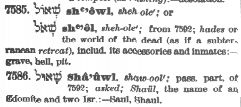
Paul=Saul=Shaul=Sheol=Hades=Hell
by
Beaufort Clifton Addison III
The First Century A.D. was a turbulent time. Even though much of the then-known Western world was brought into submission to the same Roman Empire, chaos, violence, uncertainty, and disorder seemed to be the prevailing themes in works of art of the time.
For the nation that had been known as Yisrael, being subordinate to a government led by pagans who neither reverenced YHWH, the god of the Hebrew people, nor served Him by keeping His Torah (or "Law") it was an almost unbearable shame. Some, called Sicarii or "Zealots", chose rather to undertake aggressive suicide missions against the better-equipped Roman soldiers than to live under the disgrace of Roman oppression and the further shame of the enforced toleration of Hellenism’s influence, that is, the seductive qualities of classical Greek culture.
A few centuries before, the Y’hudim ("Jews") had revolted against a similar regime, even going to the extreme of putting to the sword people of their own race who favored the new and loose Hellenic ways. The naked athletes in a recently built sports complex were seen as an "abomination" or a detestable thing in the eyes of YHWH, and thus the faithful. Further, the results of the constant fun that the Hellenizers made of openly exposed circumcision in Jewish athletes, manifesting itself in the form of efforts by Y’hudim to become uncircumcised, were equal with apostasy and worthy of death if continued in the "Holy Land", as commanded by the Hebrew god early in the sacred writings of the Yisraelites(also known as the "Tanakh" or the "Old Testament").
The general picture that one beholds occurring over and over is that of a people trying to retain its own separate identity in the face of overwhelming and often sword-wielding pressures.
It is against this backdrop that the reader first meets Shaul (or "Saul") of Tarsus in the "New Testament", in the collected sacred writings of at least two factions of a Messianic movement popular amongst the Y’hudim, whether "up" in the region of Y’hudah ("Judea") or "down" in the Diaspora.
At the time that this Shaul first starts to communicate with his readers at least two factions of a Messianic movement in the Jewish religion were extant. This Messianic movement was the inevitable outgrowth of a people confident(or, at least, hopeful) that Elohim, "the [true] mighty One" and synonymous with the Hebrew god, would deliver them out of the hands of all foreign sovereignties and once again grant them their autonomy. The person who these Messianic hopefuls believed had been "Anointed"(synonymous with "Messiah" and meaning "divinely appointed through the anointing of oil") for this purpose possessed a name, the very meaning of which was "deliverance" or "salvation [as from peril or danger]". This name was Y’shua, a phonetic duplicate of the word "y’shuah" in Hebrew. It was not until the 1600’s that the hard J sound came into being in the English language and this man became known as "Jesus." The "s" sound at the end had been added early on in the Greek texts to keep Hellenic readers from mistaking the "ah" ending to mean that he was a woman. The same change was made with names like Mosheh/Moses, EliYaHU/Elias, Messiah/Messias, Kayafa/Caiaphas and Y’sheYaHU/Isaias. With the advent of the hard "J" sound, still non-existent in Greek and Hebrew, so much of the usage of the name "Y’shua" in both the Old and New Testaments was inadvertently hidden from the eyes of Christians and Jews worldwide, so that modern traditional Jews could pose the perplexing question, "If ‘Jesus’ is the Messiah, why isn’t he mentioned by name anywhere in the Tanakh?" The answer, of course, is that he is mentioned abundantly, if one searches for his Hebrew name. After all, the idea that the Messianic movement that exalted "Jesus" could have grown so quickly out of a seeming void of Tanakhic mention should challenge any good historian’s common sense.
Even a brief survey of the uses in the "Bible" of the word "y’shuah" in the Hebrew and its equivalent forms of "soter" (also having to do with "salvation") in the Greek grants the reader an eye-opening revelation. When he was being taught to pronounce Hebrew from the text of a siddur, or Jewish prayer book, the author first discovered the possibility that the word "y’shuah" might have been used as a word play to simultaneously refer to the son of "Mary". In the liturgy was a question which ended with the word "y’shuah". Already having the knowledge that the aforementioned Jewish maiden’s son was given the Hebrew name "Y’shua", he wondered what the question might mean. Did the Jewish liturgy ask a question about Y’shua? Research on the matter revealed that the word being used was not the personal name; however, the study also revealed that there were numerous passages in the Old Testament using this word which could be taken as Messianic prophecies, prayers, and theological creeds. Subsequent casual reading in David Stern’s Jewish New Testament revealed passages in the New Testament where the same word was indeed used to refer simultaneously to the idea of "salvation" and the person of Y’shua. Y’shua, a pious claimant to Messiahship who would have spat at the idea of teaching holy things in the Greek, is portrayed as having used the word play rather overtly on one occasion when in the Good News account of Lukas he says, "Salvation/y’shuah has come to this house this day," after entering the house of Zacchaeus, a wealthy and repentant chief tax collector culturally held to be a sinner. (Lukas 19:2-10) One of the most forceful confessions of orthodox Christianity’s doctrine that Y’shua was the Heavenly Father come in the flesh finds itself hidden away from neo-Hellenistic eyes in nothing other than the Torah in the "book" of "Exodus": "YaH is my strength and song, and he is become my [y’shuah]: He is my Mighty One (or "deity") and I will prepare Him a habitation; my father’s Mighty One, and I will exalt him." (15:2) While the reader is encouraged to research this matter, so as to more completely understand the cause of not only the reception of Y’shua, son of "Mary", as the awaited Anointed One but also the advent of such a problematic doctrine as the Trinity, the purpose of this paper is not to dwell on this area of study. The author reveals this literary method of interpretation to the reader so that he will be able to see the validity of employing it in the discovery of references to Shaul of Tarsus which have been buried by translation, the evolution of the Hebrew language, and the general ignorance of Bible readers as respects the languages of the earliest known manuscripts.
Even though the already mentioned Messianic movement enjoyed such alarming growth, the problem of the influence of Hellenism and the other of the watchful and cruel eye of the Roman Empire had not dissipated. Rome and those appointed to express the Emperor’s will in Y’hudah had a vested interest in keeping this movement of political aspirants in check and under their thumb, since these Jewish subjects believed in guarding (hence the appellation "Netzarim" or "those who guard" ascribed to them) a Torah or "Law" that ran contrary to that established by the Empire. When Jews or Christians talk about "keeping the commandments" most think of this as meaning "doing the commandments," and while the meaning of the phrase includes this idea it most precisely takes it a step further. The full idea is Archaic English’s attempt to convey the Netzarim sense of "guarding" by drawing on the picture of a "keep", a small fortress outside the castle meant to guard the entrance. A fence or a wall around one’s house, meant to keep undesirables out of one’s home, could be a modern equivalent. A lock on the front door would be a last defense, but the fence would be a safeguard, so as to keep from violating the Torah, which, if obeyed, offered blessings of prosperity to individual Y’hudim and the nation as a whole. These Jewish Torah-keepers who believed that the already executed Y’shua had been the promised Anointed One who would return as a political redeemer, deliverer, and savior were known by other names such as "Evyonim", a term which meant "poor ones"(the poor received especial care from YHWH, according to the Tanakh) and "Essenes" or "doers of the word". Some of these Essenes lived communally at Qumran, not far from the Northwest coast of the salt-laden Dead Sea, reportedly where S’dom and Amora were destroyed by YHWH’s wrath and Lot’s wife was turned to a pillar of salt. The Dead Sea would have been a constant reminder to this mother of all supercults what the price of disobedience could be. Most importantly, these three embodiments of this traditional and only natural Messianic movement believed that Y’shua had kept the Torah, had taught others to do so, and had taught others to teach others to do so, all in accordance with everything that had already been revealed.
In opposition, another major faction of this Messianic movement started to rear its contrary head. Led by the driven and learned Shaul of Tarsus, the ekklesia or "assembly" started to take root in the impressive number of cities he visited throughout the Empire, mostly those that already had a sizeable community of Hellenized Jews. Teaching what the Jerusalem-based Messianic Torah-keepers would have seen as apostasy, this Shaul of Tarsus had somewhat of a bad reputation and this comes out in the New Testament. It was, however, not only amongst the ancient Messianics that Shaul was seen as a renegade.
Several notable thinkers of modern times have noticed problems inherent with Shaul’s claims and teachings. Opinions are varied: Shaul taught a different religion than Y’shua, Shaul knew very little if anything at all of Y’shua’s spoken teachings, and/or Shaul corrupted Y’shua’s teachings outright. A couple of proponents of the first view are Carl Sagan and Wil Durant. The latter, a philosopher, has said, "Paul created a theology of which none but the vaguest warrants can be found in the words of [Y’shua]," while the former, now deceased, once penned the words:
"My long-time view about Christianity is that it represents an amalgam of two seemingly immiscible parts--the religion of Jesus [or "Y’shua"] and the religion of Paul [or "Shaul"]. Thomas Jefferson attempted to excise the Pauline parts of the New Testament. There wasn't much left when he was done, but it was an inspiring document." (Carl Sagan, Scientist and Author in a Letter to Ken Schei [author of Christianity Betrayed])
This leads us to wonder what possessed and inspired Thomas Jefferson, a man who made it his business to educate himself well, to violate what had, since Athanasius, been the sanctity of a unified bible canon by removing Shaul’s writings from it. Could it have been that Mr. Jefferson held the same opinion as Albert Schweitzer and Carl Jung, the famous psychologist, that Shaul offered no personal testimony of the teachings of Y’shua, and therefore had earned no credentials worthy of someone who might clarify his teachings? Would he have given the nod to comments from Mr. Schweitzer like, "Where possible Paul avoids quoting the teaching of Jesus, in fact even mentioning it. If we had to rely on Paul, we should not know that Jesus taught in parables, had delivered the sermon on the mount, and had taught His disciples the 'Our Father.' Even where they are specially relevant, Paul passes over the words of the Lord"? Would his verbal assent have been offered after words had been spoken like "Paul hardly ever allows the real Jesus of Nazareth to get a word in"? (Carl Jung in U.S. News and World Report, April 22, 1991, p. 55) The reader must conclude that Jefferson’s motivation must have been something of this sort, though it might also have been an agreement with the last opinion that Shaul actually polluted and perverted the teachings of Y’shua. Among others, one prominent person promoting this idea is Bishop John S. Spong, the Episcopal Bishop of Newark, "Paul's words are not the Words of God. They are the words of Paul--a vast difference." (Rescuing the Bible from Fundamentalism, p. 104, Harper San Francisco, 1991) He is joined by the English philosopher, Jeremy Bentham, when he says words to the effect of "If Christianity needed an Anti-Christ, they needed look no farther than Paul." (paraphrased from Not Paul, but Jesus) Lastly, Walter Kaufmann , Professor of Philosophy at Princeton,
adds his "Paul substituted faith in Christ for the Christlike life" to Thomas Jefferson’s offering that "Paul was the first corrupter of the doctrines of Jesus." (from a letter that he wrote to W. Short found in The Great Thoughts, George Seldes, Ballantine Books, NY, 1985, p. 208) And so the reader now sees what had indeed motivated this great thinker to once again restore the New Testament to its original ante-Nicene, ante-Athanasius, form.If the teachings of Shaul of Tarsus could prompt great, modern thinkers to offer opinions such as these and engage in a traditionally "unorthodox" enterprise of segregating books of the long "set in stone" New Testament canon, one wonders what the leading minds of the Messianic movement who were contemporaneous to Shaul thought about them. The use of the Shaul/sheol word play, similar in all respects to the Y’shua/y’shuah word play, will help the reader discover the answer.
The author relates to the woman who first suggested to him that Shaul taught doctrine contrary to fundamental Judaism how he had discovered this next biblical word play:
". . . my Strong's concordance has been opened to page 111 in the Hebrew dictionary for at least a few days now. I sit down and just look over at it while I'm eating and half-way pay attention to each word. Well, I was looking at page 110 for a long time and started to glance over at 111 and noticed the word ‘sheol’, which is the Hebrew word from which [the Nordic word] ‘hell’ comes. Well, I read the meaning of #7585 and noticed that it contradicts what [Jehovah’s] Witnesses teach about ‘sheol’. Anyway, I then noticed that the very next word ahlehfbetically in Hebrew is ‘Shaul’, Paul's Hebrew name. [sarcastically] What a coincidence, hunh?"

The author continues, "Look closer at it and strip away all of the vowel points. The only difference is that a ‘cholom’(looks like a ‘vahv’ [or "wahw"] with the ‘dahgehsh’) has been inserted between the ‘ahlehf’ and the ‘lahmehd’ in ‘sheol.’ [Actually, the primary spelling of ‘sheol’, shown at the top, includes a ‘cholom’.]"

The reason the author suggested stripping away the vowel points was because they were not in existence in the Hebrew language until the Masoretic scribes introduced them between A.D. 500 - A.D. 900, when they standardized the Hebrew "bible." Shaul of Tarsus and the Messianic movement existed in the 1st Century A.D. and the Hebrew Tanakh existed for much longer. This being the case, any slight alteration of pronunciation produced by the vowel points in these two words that are spelled exactly the same offers no proof that the pronunciations were not also exactly the same in the Hebrew-Aramaic language of the 1st Century.
Was the name "Shaul" and the word "sheol" used as a word play in the Old Testament? That was a necessarily objective test that would have to be applied to this discovery to make certain that it was not all just a coincidence seen through biased eyes. After some searching, the author found two places in the Tanakh where these two Strong’s entries were used in just such a word play, though admittedly one of the passages is a verbatim copy of the other; however, the author is confident that even one passage is sufficient, due to the strength of the proof. (Incidentally, the author rejects Shaul of Tarsus’ out-of-context quotation of "in the mouth of two or three witnesses shall every word be established" in 2 Corinthians 13:1 and Christianity’s later assumption that the quotation meant that one needed to find at least two or three "proofs" of a doctrine in Athanasius’ "bible" canon to establish that teaching.) The first passage is found in 2 Sh’muel("Samuel"):
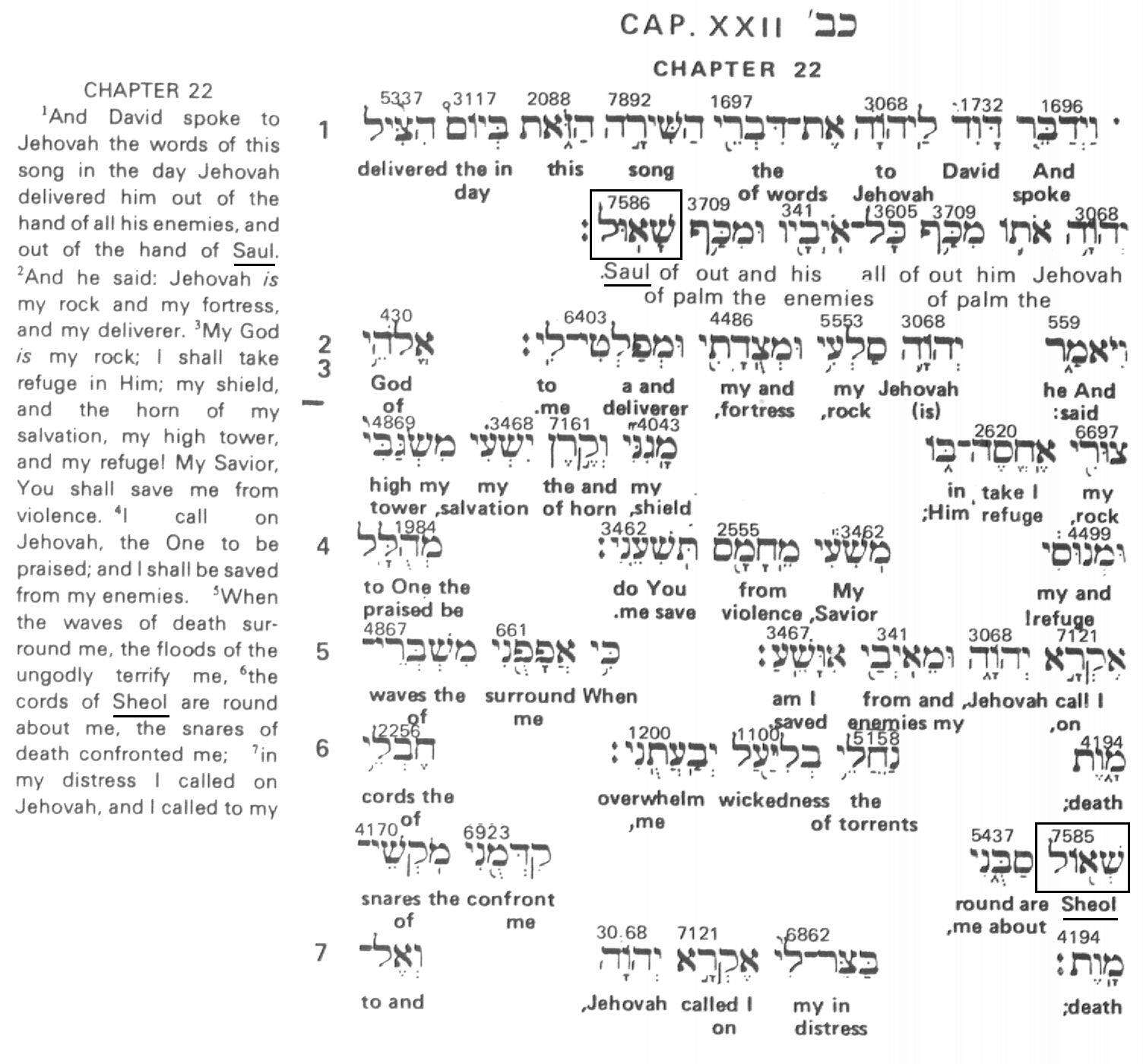
The reader should notice the words of mention in the rectangular boxes and that the first one, "Shaul"(in this case, the Tanakhic King), has the Hebrew Strong’s number 7586 and the second, the word "sheol", possesses the number just before. The two words are vowel pointed differently, but as "pointed" out, this text was originally written long before the inclusion of vowel pointing in written Hebrew; therefore, the reader should be permitted, once again, to see what these words look like without the vowel points:
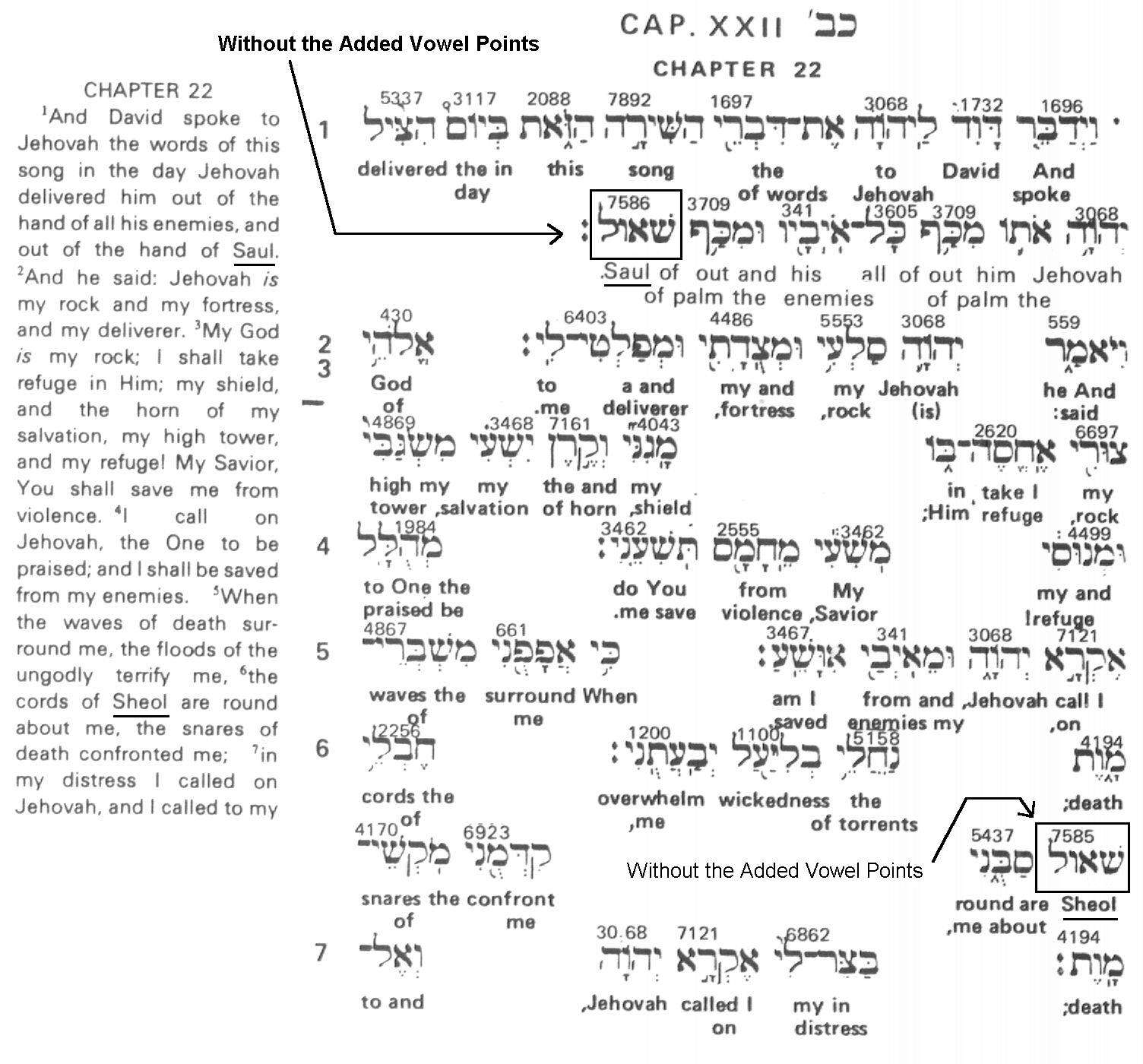
. . . and thus it is seen that the two words were spelled exactly the same: sheen, ahlehf, chohlohm, lahmehd. Additionally, it should be noted that the letter "vahv", which exactly resembles (except for added pointing) the letter "chohlohm", is usually referred to as "waw" by archeologists and those specializing in ancient Semitic linguistics. The "waw" is normally transliterated with an "ooh" or an "oh" sound by these same experts and would naturally also be pronounced similarly.
A verbatim copy of the passages concerned can be found in Psalms 18:
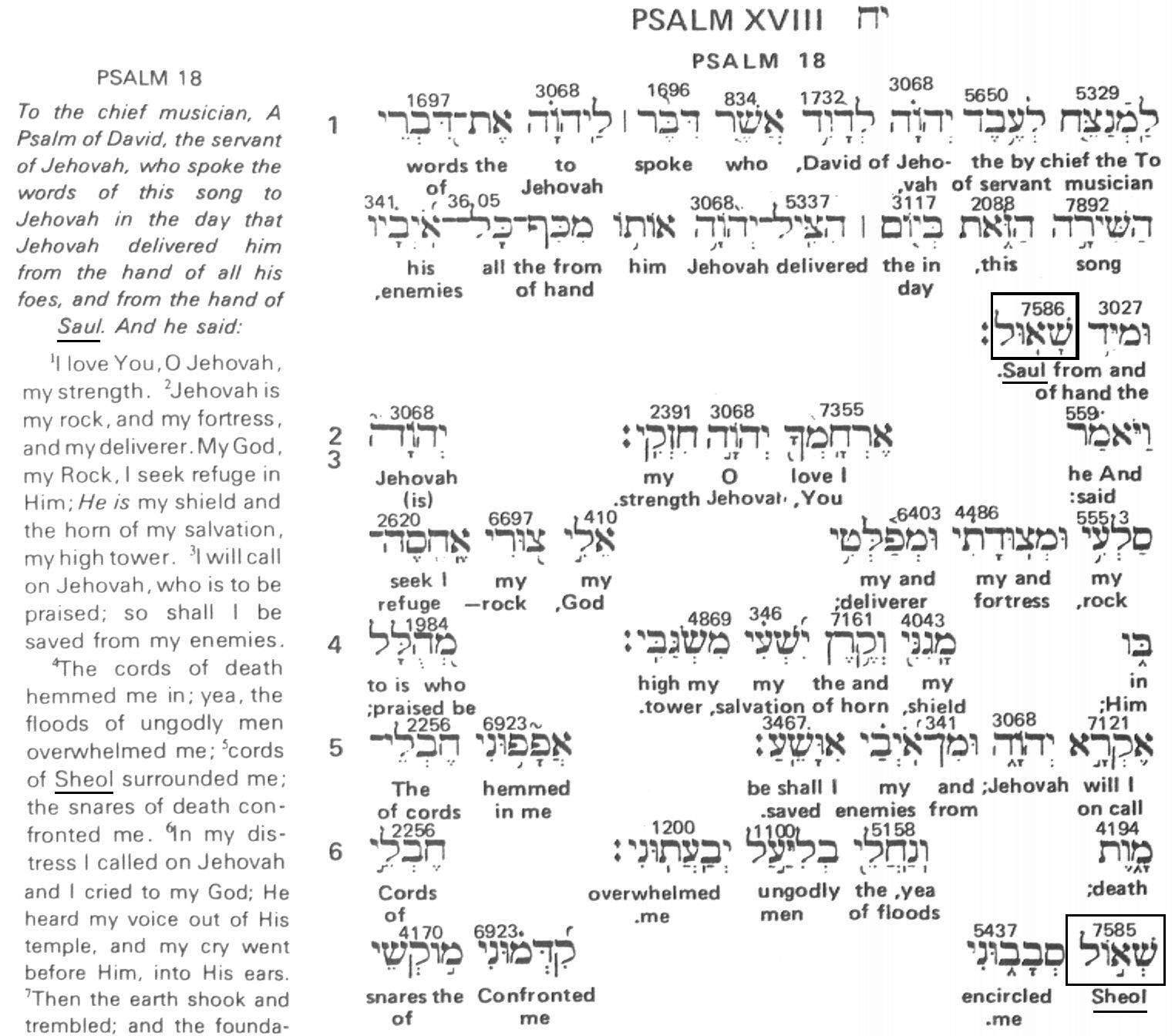
. . . and again, without vowel points:
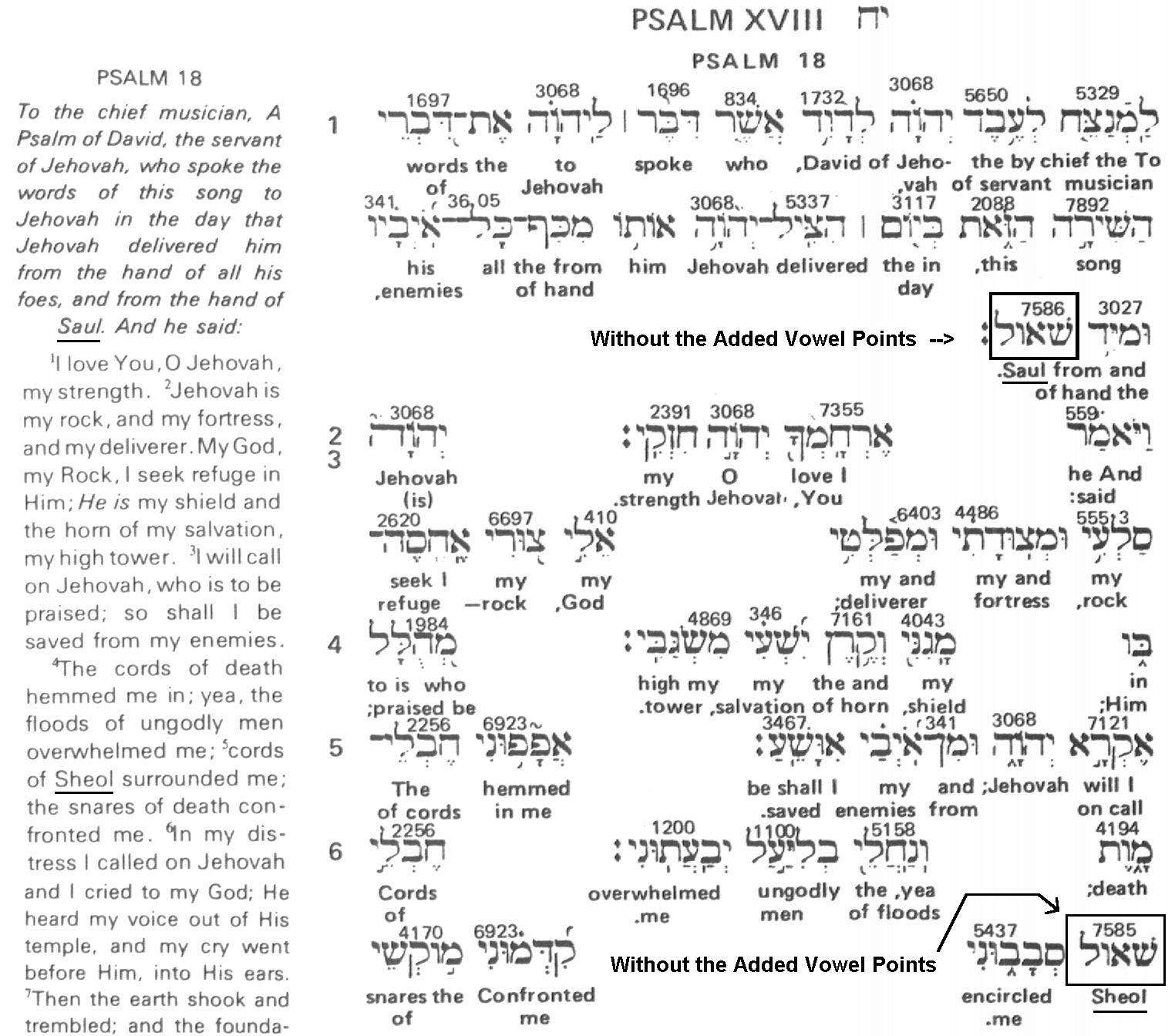
The foreword to these passages reads to the effect of, "To the chief musician, a Psalm of Dahveed, the servant of YHWH, who spoke the words of this song to YHWH in the day that YHWH delivered him from the hand of all his foes, and from the hand of Shaul." (emphasis added) The story goes that King Shaul had gone bad and earnestly desired to kill Dahveed. Dahveed had to go underground, in a manner of speaking, because Shaul and his men were hunting him down like a dog. It was for this reason that Dahveed could say, "The cords of death hemmed me in; yea, the floods of ungodly men overwhelmed me; cords [or "chains"] of sheol [typically translated "hell"] surrounded me; the snares of death confronted me." Rather than being some abstract preoccupation with the destiny of death brought on by his alleged sinfulness, Dahveed poetically pinpoints for us the source of that seemingly impending doom: the King named Shaul who was hunting him down.
Having established the existence of this word play in the Tanakh, one can peer into the New Testament to see whether it occurs there, also. Before the author expounds on some pertinent passages, however, the reader needs to be informed that in the Greek of the New Testament, "hades" is the word which was used to translate "sheol" in the Greek Septuagint, the translation of the Hebrew Tanakh into Greek.
The first passage to be treated will be the famous basis of Catholicism’s claim to succession of apostolic authority, "You are Peter, and on this rock I will build my church…" With a Hebrew-Aramaic flavor, justified by internal evidence and ecclesiastical history that such an original manuscript existed, it becomes, "You are Kefa [Aramaic for "rock mass" and possibly the etymological ancestor of "cave"], and on this rock I will build my congregation, and the gates [or "entry-ways"] of sheol shall not prevail against it." Employing the word play it becomes, ". . . I will build my congregation and the gates [or "entry-ways"] of Shaul shall not prevail against it." The Good News account of MattitYaHU ("Matthew"), from which this passage comes to the reader, has a distinctively pro-Torah theme to it missing in large measure from the other three Good News accounts. Apparently, Y’shua is here portrayed as offering a promise that the gate of the broad road to destruction mentioned in MattitYaHU 7 would not conquer the Torah-keeping Messianic congregation eternally.
This promise is reiterated in other words when someone named IAHHNN, according to the Greek attempt to transliterate the name "YaHUchanan", reports to have seen a vision of the final judgment of mankind. The events preceding this vision of a future judgment report how Satan had deceived the "nations", a word which in Hebrew would be "goyim", potentially meaning all nations including Yisrael but more commonly referring to non-Yisraelites or "gentiles". (The reader should recall that gentiles made up a substantial part of Shaul’s followers.) The vision commences:
"And I saw a great white throne, and him that sat on it, from whose face the earth and the heaven fled away; and there was found no place for them. And I saw the dead ones, small and great, stand before Elohim; and the scrolls were opened: and another scroll was opened, which is [the scroll] of life: and the dead ones were judged out of those things which were written in the scrolls, according to their works. And the sea [a symbol of Torahless mankind] gave up the dead ones which were in it; and death and sheol delivered up the dead ones which were in them: and they were judged each according to their own works. And death and sheol were cast into the lake of fire." (Revelation 20:11-14, emphasis added)
When the passage is considered in the light of the Shaul/sheol word play, the imagery of death and sheol, two abstract ideas, being cast into the fire goes from provoking a reaction of "Wowwww, that’s deep!" to "A-ha!" Shaul and his still anonymous fellow, code named "death", are judged individually for their own works, are given the thumbs down, and are subsequently tossed into the lake of fire—Gey-Hinnom—the valley where unclean trash and those found guilty of grievous Torah violation were cast.
MattiYaHU and the Revelation, both very Hebraic writings, reveal the attitude of the Torah-keeping Messianic faction towards Shaul of Tarsus and his gentile mission which abandoned so many fundamental requirements of the worship of YHWH that it was dubbed a "broad road leading to destruction."
While the scope of this area of study is larger than the space allowed for this paper, the author is confident that the reader’s eyes have been opened to a line of investigation that may yield significant rewards for any scriptorian who digs digging.
Copyright © 1998 Beaufort Clifton Addison III, All Rights Reserved
Return to
Refuting the
ApPAULing APAULogetics of the PAUL-bearers